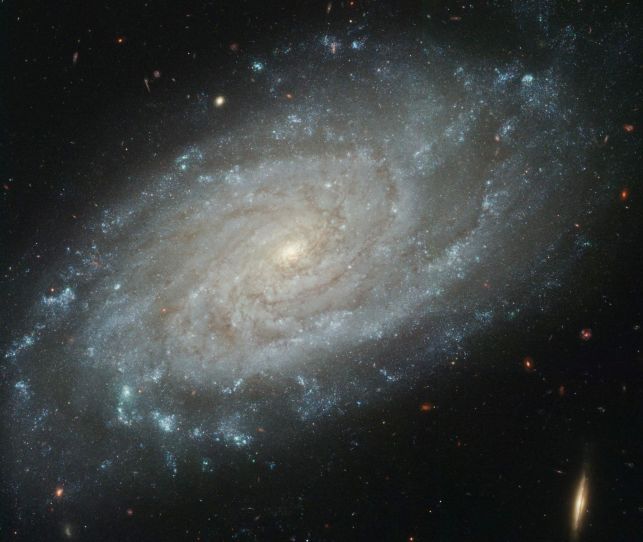Subscribe to receive new posts:
Posts Tagged ‘mathematics’
Math Proves Atheism and Materialistic Determinism are Unprovable Beliefs
A mathematical problem underlying fundamental questions in particle and quantum physics is provably unsolvable, according to an online report on phys.org December 9, 2015. It is the first major problem in physics for which such a fundamental limitation could be proven. The findings are important because they show that even a perfect and complete description of the microscopic properties of a material is not enough to predict its macroscopic behavior.
A small spectral gap the energy needed to transfer an electron from a low energy state to an excited state is the central property of semiconductors. In a similar way, the spectral gap plays an important role for many other materials. When this energy becomes very small, i.e., the spectral gap closes, it becomes possible for the material to make a phase transition to a completely different state. An example of this is when a material becomes superconducting.
Mathematically extrapolating from a microscopic description of a material to the bulk solid is considered one of the key tools in the search for materials exhibiting superconductivity at ambient temperatures or other desirable properties. A study, published (12/9/15) in Nature, however, shows crucial limits to this approach. Using sophisticated mathematics, the authors proved that, even with a complete microscopic description of a quantum material, determining whether it has a spectral gap is, in fact, an undecidable question. read more
Science and Judaism: Biblical Numbers, Mathematics and Attributed Patriarchal Ages
Credit: Roger Price
The Hebrew Bible is filled with numbers. There are different kinds of numbers — cardinals and ordinals, integers and fractions, even primes. And they are everywhere in the Torah text.
There are numbers for days. (See, e.g., Gen. 1:5, 8, 13.)
There are numbers for life spans. (See, e.g., Gen. 5:5, 8, 11.)
There are numbers for populations, i.e., census numbers. (See, e.g., Ex. 1:5, 12:37; Num. 1:46, 2:32.)
There are numbers for the measurement of quantities. (See, e.g., Ex. 16:22, 36, 29:40.)
And for sizes. (See, e.g., Gen. 6:15.)
There are numbers for the duration of events. (See, e.g., Ex. 12:40, 24:18.)
There are numbers for a host of seemingly mundane things, such as the number of visitors and the number of palm trees. (See, e.g., Gen. 18:2; Ex. 15:27.) read more
Science and Judaism: WWMD? What Would Maimonides Do?

Credit: NASA AS8-14-2383
Rabbi Moshe ben Maimon, Maimonides, also known by the acronym Rambam, lived just over eight hundred years ago (1138-1204 CE). He never saw the planet Earth as astronaut William Anders did on December 24, 1968 when module pilot Anders took the now iconic photograph above while flying over the lunar surface during the first manned orbit of the Moon. We do not know if Maimonides even imagined such a sight.

Credit: NASA/JPL P41508
The picture above shows Earth with the Moon in the background. This scene was captured by the Galileo Orbiter on December 16, 1992 at a distance of almost four million miles from our home planet. Maimonides never had the opportunity to see Earth and Moon from this perspective either.
Credit: NASA, The Hubble Heritage Team and A. Riess (STSci). PRC2003-24.
Living some four hundred years before Nicolaus Copernicus considered the nature of the solar system and Galileo Galilei fashioned his first telescope, Maimonides did not realize that the Earth circled the Sun, and not the other way around as was commonly understood in his day. Nor could he have known that the Sun was but one medium sized star in a rather unremarkable galaxy known as the Milky Way which spans 100,000 light years and is similar in size and shape to the spiral galaxy NGC 3370 shown above in a picture taken by the Hubble Space Telescope. Similarly, he would not have known either that our galaxy consisted of a few hundred billion stars, give or take, or that the Milky Way was but one of perhaps a hundred billion galaxies, give or take, in the visible universe. See Tyson and Goldsmith, Origins (W.W. Norton, 2005), at 27, 150. read more
Science and Judaism: The Strange Claim of Dr. Schroeder (Part II)
In a prior post (10/18/11), we started to look at Dr. Gerald Schroeder’s argument in The Science of God (“TSOG”)(rev. ed. 2009) that the six biblical days of creation and the billions of years of the evolution of the universe as measured by scientists actually occurred over the same time period. Our focus was on Schroeder’s interpretation of certain biblical passages that he believes show that time is treated differently before and after the creation of Adam. (See, e.g., TSOG, at 52, 54.)
Now we are going to address that part of Schroeder’s argument that rests of physics and mathematics. In the concluding post of this series, we will review the conclusion of Schroeder’s conflation argument. read more
The Greenberg Hurdle
Irving (“Yitz”) Greenberg is an American orthodox rabbi, known for critical thinking and reaching across denominational lines. In 1977, writing about the Holocaust, Greenberg argued that in the future, “no statement, theological or otherwise, should be made that would not be credible in the presence of burning children.” A few years later, Greenberg repeated that proposition in a seminal essay entitled “The Third Great Cycle in Jewish History.”
read more




